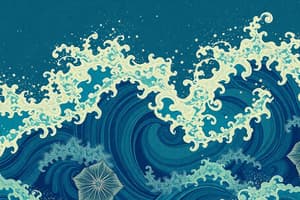Podcast
Questions and Answers
Which behavior do waves exhibit when they encounter the end of a medium?
Which behavior do waves exhibit when they encounter the end of a medium?
- Transmission and refraction
- Refraction and absorption
- Absorption and reflection
- Reflection and transmission (correct)
What can be used to study the behavior of two-dimensional waves like water waves?
What can be used to study the behavior of two-dimensional waves like water waves?
- A stethoscope
- A telescope
- A microscope
- A ripple tank (correct)
What happens when straight waves encounter an obstacle?
What happens when straight waves encounter an obstacle?
- They stop completely
- They split into multiple waves
- They bounce off and change direction (correct)
- They continue straight through the obstacle
What is the behavior of waves reflecting off a parabolic surface?
What is the behavior of waves reflecting off a parabolic surface?
What is refraction?
What is refraction?
In what type of water do water waves travel fastest?
In what type of water do water waves travel fastest?
What is diffraction?
What is diffraction?
What is the relationship between wavelength and diffraction?
What is the relationship between wavelength and diffraction?
Which animals use diffraction of sound waves to communicate across long distances?
Which animals use diffraction of sound waves to communicate across long distances?
Flashcards are hidden until you start studying
Study Notes
Reflection, Refraction, and Diffraction of Waves
- Waves undergo specific behaviors when they encounter the end of a medium, including reflection and transmission.
- Two-dimensional waves, such as water waves, can be studied using a ripple tank to observe reflection, refraction, and diffraction.
- A linear object in water can become a source of straight waves with alternating crests and troughs.
- When straight waves encounter an obstacle, they bounce off and change direction according to the law of reflection.
- Waves reflecting off a parabolic surface converge at a focal point and spread out again.
- Refraction involves a change in direction, speed, and wavelength of waves passing from one medium to another.
- Water waves travel fastest in deep water and slow down and bend when passing from deep to shallow water.
- Refraction is observed in a ripple tank partitioned into deep and shallow sections.
- Diffraction is the bending of waves around obstacles and openings and is observed in water waves, sound waves, and light waves.
- The amount of diffraction increases with increasing wavelength.
- Diffraction of sound waves is commonly observed and used by forest-dwelling birds such as owls to communicate across long distances.
- Diffraction of light waves is only observed when encountering obstacles with extremely small wavelengths.
Studying That Suits You
Use AI to generate personalized quizzes and flashcards to suit your learning preferences.




